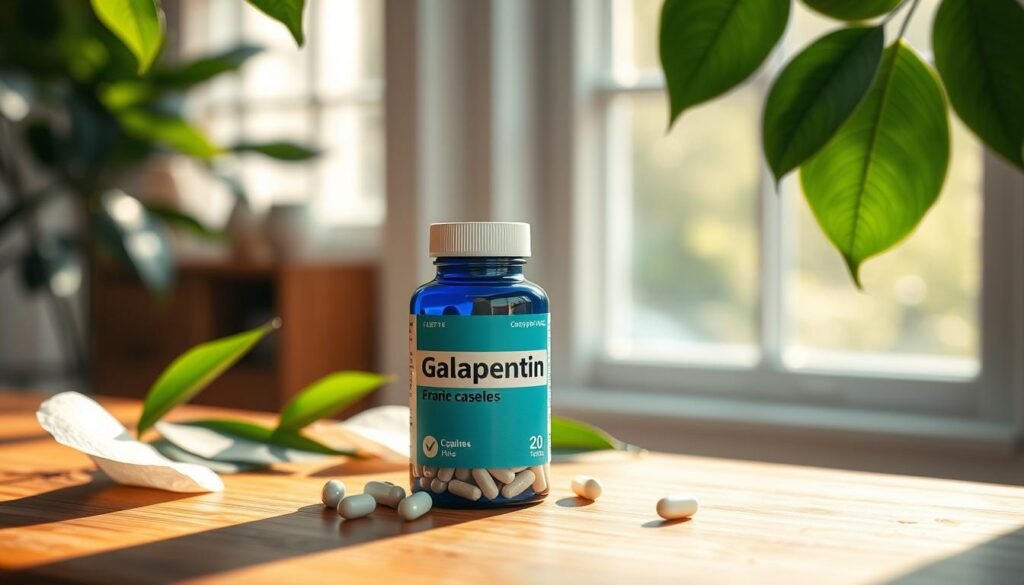Did you know about 40 million adults in the US face anxiety each year? This significant number shows a strong demand for effective treatments. Gabapentin is becoming a hopeful choice for many as an off-label option. Originally used for nerve pain, it’s now helping those with anxiety disorders who haven’t found relief elsewhere.
This guide explores how gabapentin helps with anxiety, including how it works and tips for use. It will also cover the side effects. Knowing the right dosage and treatment plan is key to good results and symptom management. If usual anti-anxiety medicines haven’t worked for you, gabapentin might be an option to think about.
Key Takeaways
- Anxiety affects around 40 million adults in the U.S. annually.
- Gabapentin’s effective dose for anxiety ranges from 300 mg to 3,600 mg daily.
- Improvement in anxiety symptoms can typically be observed after 4-8 weeks of treatment.
- Gabapentin may be beneficial for individuals with a history of ineffectiveness from other anti-anxiety treatments.
- It’s crucial to consult a healthcare professional before starting any new medication.
Understanding Gabapentin and Its Uses
Gabapentin is an anticonvulsant medication used mainly for seizures and nerve pain. It is often prescribed for conditions like shingles and neuropathy. This helps ease pain and reduce symptoms. Besides its main uses, gabapentin is also sought after for treating anxiety.
Despite being made for seizures, gabapentin’s benefits for anxiety are notable. It works by acting like the brain’s GABA neurotransmitter, which calms excessive brain activity. This can lead to less anxiety after starting the treatment.
Gabapentin’s use for anxiety shows its wide-ranging abilities. It offers an option for those seeking alternatives to typical anxiety medications. When used with therapies like cognitive behavioral therapy, it can create a comprehensive anxiety treatment plan.
| Dosage Forms | Strengths |
|---|---|
| Tablets | 300, 600, 800 mg |
| Oral Solution | 250 mg per 5 ml |
| Capsules | 100, 300, 400 mg |
| Extended-Release Tablets | 300, 600 mg |
It’s essential to understand the different Gabapentin uses. This helps patients and doctors choose the best treatment for both anxiety and nerve pain. With the right advice and care, gabapentin can be an effective part of managing these issues.
What is Gabapentin?
Gabapentin is a medication often given out by doctors. It treats a bunch of nerve issues. You may know it as Neurontin, and it’s also used for anxiety. The U.S. Food and Drug Administration (FDA) first said yes to it in 1993 for epilepsy. But now, it’s also known for helping with anxiety.
This drug works by connecting to certain spots on calcium channels in the nervous system. It changes how neurotransmitters are released. This process can make anxiety symptoms like worry, restlessness, and irritation less intense. People with Generalized Anxiety Disorder (GAD) might find it really helps.
Gabapentin comes in different forms: capsules, tablets, and liquid. This makes it easy for all kinds of patients to use it. Research shows it can really cut down anxiety symptoms in many people, including those hard-to-treat cases of GAD. The amount you take can vary, from 900 to 2,400 milligrams a day, spread out over multiple doses. This lets doctors make the treatment suit each person’s needs.
But gabapentin isn’t just for anxiety. It’s also given out for things like nerve pain, restless legs syndrome, and postherpetic neuralgia. Since it can tackle various health problems, it’s a top choice for lots of patients.
How Gabapentin Works for Anxiety
Understanding how Gabapentin Mechanism works is key to knowing why it helps with Anxiety Relief. It starts its work by targeting specific parts of nerve cells. This slows down the sending of too many messages that make us feel worried or scared.
The success of Gabapentin in easing anxiety can vary from one person to another. How severe the anxiety is matters a lot. Some may notice improvements in their feelings of anxiety within three weeks. But, this can be different for everyone.
Even though the FDA hasn’t approved Gabapentin specifically for anxiety, doctors still prescribe it. It’s especially used for general anxiety and stress situations. People stopping benzodiazepines find Gabapentin helpful in lessening anxiety symptoms. They need the right dosage for it to work well.
Gabapentin shows promise in easing anxiety, despite needing more research for a full understanding. It remains a beacon of hope for those battling with ongoing anxiety issues.
Gabapentin Dosage for Anxiety: Treatment Guide
It’s important to know the right Gabapentin Dosage for managing anxiety. This medicine was first made to treat seizures and nerve pain. But now, it’s also used for anxiety disorders. Doctors must carefully decide on the dosage for the best results.
Starting Dosage Recommendations
The Starting Dosage for Gabapentin begins at 300 mg each day, split into three doses. This slow start helps patients get used to it while keeping side effects low. For anxiety, you often need less medicine than for seizures.
Dosage Adjustments and Titration
After starting treatment, doctors might change the dose based on how the patient reacts. They watch closely for any increase in anxiety symptoms. Changing the dosage is done slowly to stay effective and limit bad reactions.
Maximum Dosage Considerations
The Maximum Dosage of Gabapentin can go up to 3,600 mg daily, depending on the case. It’s important not to exceed this limit to avoid side effects like dizziness and nausea. Regular doctor visits are key to safe and effective treatment.

For more details on Gabapentin dosage and anxiety treatment, check this resource.
Gabapentin Off-Label Use for Anxiety
Gabapentin is increasingly recognized for its off-label use in treating various anxiety disorders. It was first approved for seizure control. Many healthcare professionals have seen its potential in easing anxiety symptoms. This is especially true for patients who don’t do well with usual anxiety treatment options like SSRIs or benzodiazepines.
Research shows more evidence that gabapentin can help manage anxiety. Studies suggest a promising link between gabapentin dosage and anxiety levels. As the dosage goes up, anxiety tends to go down. Treatment often starts at 300 mg once in the evening. Doctors may increase this amount depending on how the patient responds.
Gabapentin isn’t FDA-approved for treating anxiety, but it’s still a popular choice. Its maximum dosage can go up to 3,600 mg daily. However, doses differ based on the needs of each person. By 2016, doctors in the United States had written over 64 million prescriptions for gabapentin. This shows it’s becoming well-known for more than just its original use.
Using gabapentin this way requires careful consideration. Non-FDA approved drugs like gabapentin have risks, including misuse. About 15% to 22% of people with substance use issues have misused gabapentin. This fact highlights the importance of doctor supervision and detailed treatment plans.
To sum up, gabapentin has potential for anxiety treatment options, especially for those who haven’t benefited from standard drugs. Still, ongoing studies and careful use are key to safely incorporating it into anxiety disorder treatments.
Potential Side Effects of Gabapentin
Gabapentin helps with anxiety and other conditions. But it has side effects people should know about. Knowing the risks helps users watch their health and get help when they need it.
Common Side Effects
Users of gabapentin may face several common side effects. These include:
- Dizziness
- Drowsiness
- Fatigue
- Nausea
It’s key to know about these effects. They can affect your day-to-day life. If symptoms get tough, talk to a doctor.
Serious Side Effects to Watch For
Gabapentin can also cause serious problems. Watch out for:
- Mood changes
- Suicidal thoughts
- Unusual bruising or bleeding
Talking to your doctor about these side effects is crucial. Get help right away if you feel more depressed or anxious, or if you notice mood changes.
Understanding gabapentin’s risks makes therapy management better. Always watch how you react to the medication.

Comparing Gabapentin with Other Anti-Anxiety Medications
When looking at anxiety treatment options, knowing how different medications stack up is key. Gabapentin is a standout choice among other anti-anxiety drugs. It’s often weighed against SSRIs and benzodiazepines like Xanax. Each drug offers unique benefits and challenges, which makes choosing the right one crucial.
SSRIs and SNRIs as Alternatives
SSRIs and SNRIs are commonly prescribed for anxiety. They change the brain’s neurotransmitter levels. Yet, they can cause side effects like weight gain, sexual problems, and stomach issues. These side effects have some people seeking other options, including gabapentin.
Deciding between Gabapentin and SSRIs means comparing each one’s pros and cons.
Advantages of Using Gabapentin
Gabapentin has multiple benefits for anxiety sufferers. It may lead to fewer side effects than SSRIs and SNRIs. With Gabapentin, there’s a reduced risk of addiction and less withdrawal, unlike with benzodiazepines like Xanax. This makes it a solid choice for those who haven’t done well with other treatments.
Research and Studies on Gabapentin for Anxiety
Recent Gabapentin Research shows how gabapentin could help with anxiety. A review looked at 55 trials and 15 studies. It found gabapentin could help, especially when people stop using benzodiazepines.
Findings from Recent Studies
Studies have looked into how gabapentin can lessen anxiety before surgery. It was more effective than pregabalin. Against a placebo, gabapentin showed promise in treating various anxiety disorders.
Case Studies and Anecdotal Evidence
Anecdotes and case studies show gabapentin can reduce anxiety. For instance, one person felt better with 900 mg of gabapentin daily. This improvement continued over 10 months, tracking with the dose.

A study’s graph showed anxiety changes with different gabapentin doses. Anxiety came back when the dose dropped. This suggests careful dose management is vital. Though promising, more research is needed to fully understand gabapentin’s long-term effects.
Consulting with Healthcare Professionals
Talking with healthcare experts about Healthcare Consultation is very important, especially when thinking about gabapentin for anxiety. Keeping up Medical Supervision during treatment is key. It helps doctors make the treatment right for each person.
Meeting regularly with healthcare providers keeps you safe and makes sure the treatment works well. It allows them to watch for side effects and change the dose if needed.
Importance of Medical Supervision
Doctors are crucial in managing gabapentin use because it might cause dizziness or tiredness. They watch closely to safely adjust the dose and avoid problems. Ongoing gabapentin discussions create a safe and aware environment. This is extra important for patients with other health issues, like kidney problems.
Questions to Ask Your Doctor
Before starting treatment, it’s wise to ask doctors several key questions. This helps in making informed choices. You might want to know:
- What dosage of gabapentin is right for my condition?
- Are there any interactions with my other medicines?
- What side effects should I watch for?
- Are there other ways to treat my condition?
Asking these Gabapentin Discussion Points makes patients feel more supported and informed as they start their treatment.
How to Take Gabapentin Safely
Following safe guidelines for taking Gabapentin is key. This ensures you get its full benefits without facing risks. It’s vital to follow the Dosage Guidelines your doctor gives you. This will help you take it correctly.
Guidelines for Administration
Always take Gabapentin as your doctor tells you. Stick to the doses they prescribe. You can take it with or without food. But, try to take it at the same time every day. This helps keep the medication levels steady in your body. Here’s what you should do:
- Begin with the initial dose recommended. It’s usually about 300 mg per day for anxiety.
- Watch out for side effects like dizziness or feeling sleepy, especially when you start.
- Steer clear of alcohol because it can make side effects worse.
- Never change your dose without talking to your doctor first.
What to Do if You Miss a Dose
If you forget to take a dose, it’s important to follow the Missed Dose Protocol. Take the missed dose as soon as you remember it. If it’s almost time for your next dose, just skip the one you missed. Go back to your regular schedule. Don’t take two doses at once. Also, remember to:
- Double-check your medication schedule to avoid mistakes.
- Keep a log of your doses to help you stay on track.
- If you miss doses often, talk to your healthcare provider.
Lifestyle Modifications to Enhance Gabapentin Effectiveness
Making healthy choices can greatly boost Enhancing Gabapentin Treatment. Many patients see big improvements in mental health by adjusting their routines. This makes gabapentin work better. It’s crucial to focus on a balanced diet, regular exercise, and getting enough sleep.
Diet and Exercise Recommendations
Eating well and staying active are key for managing anxiety. A diet full of fruits, veggies, grains, and lean meats helps your mood. Regular aerobic activities like walking or biking reduce anxiety. Try to get at least 150 minutes of exercise weekly to improve both mind and body.
Therapeutic Approaches Alongside Medication
Adding therapy like CBT or mindfulness to medication can raise recovery chances. These methods teach ways to handle anxiety better. This creates a complete treatment plan, making gabapentin more beneficial.
Conclusion
Gabapentin is becoming popular for treating anxiety. It’s known for helping with seizures and nerve pain. Yet, its use in anxiety is getting attention.
Studies show it may work by increasing brain GABA levels. This change can ease anxiety symptoms. For some, it’s an option when other treatments fail.
Starting treatment with gabapentin involves careful dose adjustment. It usually begins at 300 mg in the evening. Then, it’s adjusted based on how one reacts to it.
Side effects are possible. Talking with doctors ensures a plan that fits one’s needs. Adding therapies like CBT can make gabapentin even more effective.
People with anxiety should explore all choices. Knowing how gabapentin works and its needs for medical guidance is key. This info helps in making wise health decisions.
For more info, look into gabapentin’s benefits and risks. Good resources include Gabapentin for Anxiety and Depression and Topamax for Anxiety Treatment.